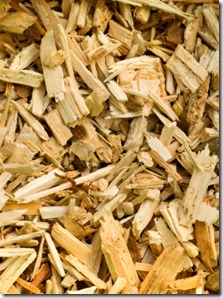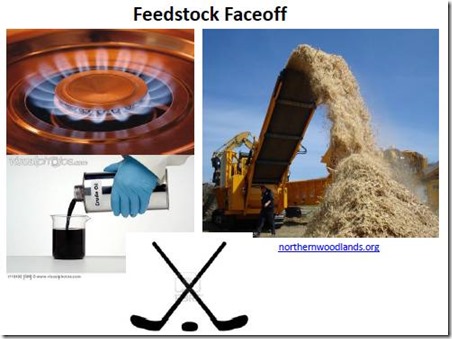Guest Post by Dr. Robert Humphreys
 Just about anyone who has even a passing awareness of current events will have heard of the national priority to replace petroleum with renewable sources of energy as part of the vision to achieve “energy independence.” Biomass-derived fuels play a prominent role in the national plan. The United States Department of Energy (DOE) 2005 “Billion-Ton Study”1 estimated that the USA could produce a billion dry tons of lignocellulosic biomass, sometimes referred to as “second generation biomass feedstock,” that could replace about 30% of the petroleum consumed annually in the USA. As this study and the follow-up “Billion-Ton Update”2 explain, a substitution of this magnitude will require daunting changes in agricultural policy, practices and technologies, types of crops produced, and land use. This objective seems achievable without a huge disruption in our way of life, but one needs to remember that predictions about a change of this magnitude and complexity are of high risk. Petroleum is still the dominant feedstock for fuel, chemicals, and polymers, although shale gas is gaining in importance as a transportation fuel and a source of ethane for ethylene/polyethylene production.
Just about anyone who has even a passing awareness of current events will have heard of the national priority to replace petroleum with renewable sources of energy as part of the vision to achieve “energy independence.” Biomass-derived fuels play a prominent role in the national plan. The United States Department of Energy (DOE) 2005 “Billion-Ton Study”1 estimated that the USA could produce a billion dry tons of lignocellulosic biomass, sometimes referred to as “second generation biomass feedstock,” that could replace about 30% of the petroleum consumed annually in the USA. As this study and the follow-up “Billion-Ton Update”2 explain, a substitution of this magnitude will require daunting changes in agricultural policy, practices and technologies, types of crops produced, and land use. This objective seems achievable without a huge disruption in our way of life, but one needs to remember that predictions about a change of this magnitude and complexity are of high risk. Petroleum is still the dominant feedstock for fuel, chemicals, and polymers, although shale gas is gaining in importance as a transportation fuel and a source of ethane for ethylene/polyethylene production.
Most biofuels (eg. ethanol, biodiesel), renewable chemicals (eg. citric acid), and renewable polymers/plastics (eg. polylactic acid, or PLA) that are produced currently utilize “first generation” feedstocks, such as plant-derived sugars, starches, and oils that also are critical sources of human nutrition.
In one future world model, petroleum, natural gas and first generation biomass will be substantially replaced by lignocellulosic biomass, sometimes called “non-food” biomass, as the major feedstock for manufacture of fuels, chemicals, and polymers. There can be little doubt that such a shift in feedstock sourcing will have major consequences for the chemical industry, including polymers and plastics. On the other hand, this shift must happen if bioplastics, a major focus of this blog site, are to reach their potential. For this reason, we will examine the second generation biomass challenge in more detail in the next few posts.
Second Generation Feedstock Supply and Conversion Processes Are Strongly Linked
The Second Generation Biomass Feedstock challenge3 can be considered in four parts:
1) Growing and harvesting enough lignocellulosic biomass to supply a billion tons of dry biomass for production of biofuels and bioproducts4.
2) Transporting biomass to a location where it can be processed.
3) Converting biomass into forms that can be processed efficiently.
4) Processing biomass to produce biofuels and bioproducts.
Many different processes for conversion of biomass to biofuels and bioproducts are under development and it is not obvious even to the experts which of these processes will be eventual winners in the marketplace. Depending on the process technology, conversion into fuels and chemicals can require biomass feedstock in significantly different forms, such as: fine particles; biomass with low and consistent moisture content; partial or complete separation into cellulose/hemicellulose/lignin fractions; and sugars via depolymerization of cellulose and hemicellulose. Such processing can be water and/or energy intensive, which will add to cost and complexity.
Another example of interconnectivity in 1-4 above is biomass crop development and biomass-to-fuels-and-chemicals processing technology. Engineering of crops to reduce lignin content while maintaining high biomass productivity (tons biomass/acre) many be advantageous for conversion processes that depend on carbohydrates only, in which lignin is a waste material or a potential inhibitor (fermentation, some thermal conversions), or for processes in which lignin causes formation of undesirable byproducts (eg. char in some thermal conversion processes).
Other examples of interconnectivity can be identified and are important to the success of biofuels and bioproducts industries. In future posts, we will explore 1-4 above, with emphasis on connectivity between second generation biomass feedstock and the processes employed to convert this feedstock to renewable fuels and bioproducts.
References:
Hockey stick and puck image from: ice-hockey-sticks-puck.jpg . Natural gas image from: mlpguy.com . Sources of other images shown in figure above.
1) “Biomass as Feedstock for a Bioenergy and Bioproducts Industry: The Technical Feasibility of a Billion-Ton Supply,” April 2005, available at https://feedstockreview.ornl.gov/pdf/billion_ton_vision.pdf .
2) “U.S. Billion-Ton Update: Biomass Supply for a Bioenergy and Bioproducts Industry,” August 2011.
3) We are focusing on the situation in the USA, but assume that the long term situation for second generation feedstock will apply elsewhere. Note that the discussion does not cover many issues that are vital to successful fulfillment of the Billion Ton vision, such as economics, mandates (government “push”), and development of adequate demand (market “pull”).
4) Use of the term “bioproducts” in this document is meant to include basic chemicals, specialty chemicals, monomers, polymers, coke, and any other co-products from biomass conversion to biofuels or renewable chemicals/monomers/polymers/other products from conversion of biomass without co-production of biofuels.


In future world model, petroleum, natural gas and first generation biomass will be substantially replaced by lignocellulosic biomass, sometimes called “non-food” biomass, as the major feedstock for manufacture of fuels, chemicals, and polymers.Himalaya Polytech is best polymer manufacture in India. Thay provides the bst polymer in its class. they made polymer for storage bottel, Jars and industrial plastic.
Thanks for this useful information, Today polymer is important part of our life. We use it in our daily life,so many things that we use are made of with polymer.